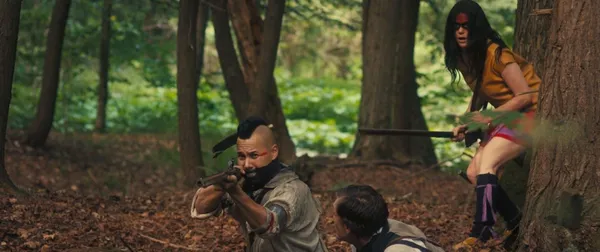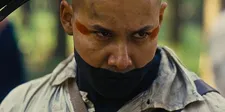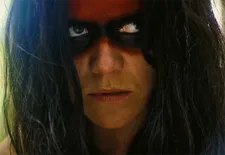 |
| Justin Rain, Eamon Farren and Kaniehtiio Horn in Mohawk |
Most indie filmmakers, looking to shoot on a low budget, first consider the stories they might tell set in their own times and their own neighbourhoods. Ted Goeghegan's ambition is of a different order. In Mohawk, released today on VoD and Digital HD, he sets out to tell a two hundred year old war story about an intercontinental conflict and its impact on a persecuted people. The film, considering its budgetary restrictions, makes a lot more impact than you might expect. I asked him how it came about.
“I grew up in rural Montana in the Western part of the United States, and I was constantly around Native American people," he begins. "Ten years ago I moved to New York City and I was very surprised by the lack of indigenous people that I saw while living in Manhattan, but at the same time I was very surprised to discover the majority of the buildings in Manhattan had signs on them, or plaques, that would state ‘built with Mohawk construction’ or ‘built with Mohawk iron’, and I was very curious about what that meant. Although I was aware of the fact that the Mohawk were a native people in America, all I really knew of them was the eponymous haircut. So I started reading up on the Mohawk and quickly discovered that Mohawk construction workers were responsible for building the majority of the city that I now called home. I felt a compulsion to learn more about these people who were so foreign to me yet were the native people in the land that I now called home.
 |
| Justin Rain as Calvin Two Rivers |
“Upon learning about them, I quickly discovered so much about the heartache and horrors that they had to go through as a people – like the majority of native and indigenous North Americans have over the past several hundred years – that ultimately it inspired a story that became the film Mohawk. Given the political and social turmoil that’s going on in the United States right now, I wanted to make a film that one: embodied my own political beliefs, but two: was the story of a marginalised people who, whilst attempting to keep their heads down, just faced further and further and further destruction until they ultimately had to strike back – a sentiment and a reality that is unfortunately still happening in the US all the time.”
How did he begin trying to do justice to such a wide reaching story in one small film?
“One has to factor in that films set two hundred years ago are usually made for a hundred times the budget of our independent film, so we not only were dealing with the budgetary limitations of making an independent film about the war of 1812, but also, like you said, the enormity of what occurred, and treating it with the respect and gravitas that it deserved. When writing the story I knew from day one that it had to be about a very small amount of people who were representative of all of the people who existed during this time and what they went through. James Cameron, while directing Titanic, told people that the way that you care about thousands of people dying is by caring about two people dying. We took that to heart and we tried our best, in the creation of this film, to really make Oak and Calvin – and Joshua, their British companion – we wanted them to embody not only the Mohawk people but the Mohawk spirit from that time.”
With a basic grounding in that priod of history myself, I found events in the film fairly easy to get up to speed on, but I wonder how it will be received by viewers less familiar with, say, the War of 1812 or the polyamorous relationship structure that is an questioned aspect of its protagonists' lives. Ted isn't worried, however.
“I’m not a fan of explaining things!” he laughs. “Any chance I get to leave it up to audience expectations or audience knowledge or lack thereof, I’m all about. We Are Still Here, the film that I directed three years ago, is extremely ambiguous, and that’s the way I like it. In the case of this film we purposely chose a time in American history that was not well documented in cinema. There are lots of films about the Revolutionary War and lots of films about our Civil War but the time in between that, the War of 1812, is not often featured in cinema. So it gave us the opportunity to work with a nearly blank slate in terms of what people expect from films set during this time. We don’t expect people to know much about the War of 1812, and what we want people to be able to get out of Mohawk is a story about marginalised people being hunted down by white men who don’t realise they’re on the wrong side of history – again tying in to just how timely this film is – and the fact that not only are they people of colour but they do have a non-traditional relationship.
 |
| Eamon Farren and Kaniehtiio Horn |
“We wanted to make sure that we were telling accurately what the Mohawk went through during this time period, but at the same time we wanted to make sure that the plight of these people – both the Mohawk and the characters in this film – was indicative of all marginalised people and what they go through on an unfortunately daily basis, even now.”
One thing that struck me about the film was the way that, as in Alfred Hitchcock's Psycho, it seems to switch leads halfway through. I ask if that was deliberate, so that white audiences have a white man to relate to until they have had time to get to know the main Mohawk character who moves to the centre of the action.
“The character which Eamon [Farren] plays, Joshua, the British Indian agent, they were real historic figures who were sent out by the British government to infiltrate Native American communities and give them weapons to fight against the new Americans; it’s not unlike what the US is doing in the Middle East right now by going into villages, giving them weapons in order to fight ISIS – whether or not that’s a good thing will ultimately be left up to history – but in the case of this film we felt it was very important to not only show these new Americans and these native people but slo the people that they surrounded themselves with, and during the War of 1812, obviously, the British were everywhere.
“We wanted to tell the story of this one British man in this community, and if white audiences automatically assume that he is going to be the lead I’m all for that, because I like to subvert that expectation. But in a film called Mohawk, and given the fact that we spend around fifty percent of the time with our heroes and fifty percent of the time with our villains, to me it was very important that the lead has to be this Mohawk woman.”
She's a compelling character. How did he approach casting?
“So, Kaniehtiio Horn, who plays Oak, is a Mohawk woman, and when writing the script, my co-author Grady Hendrix and I, throughout the process, kept telling ourselves that if we were unable to find the right Native people to play these roles, we were not going to make this movie. Because all too often, especially these days, Native roles in westerns or in period pieces are often played by other actors of colour, Latinos, I even recently saw a film where native New Zealanders, Maori, were playing Native Americans. It’s deeply unfortunate that because of the atrocites committed against the native people of North America there are unfortunately very few of them left; that said, I knew that we could find the right people for these roles.
 |
| Kaniehtiio Horn as Oak |
“We finished the screenplay and I sent it to my director of photography, Karim Hussain, just to get his opinion on it. He read it and got back to me and said ‘There is an actress whom I directed in a short film as part of the anthology film The Theatre Bizarre, her name is Kaniehtiio Horn and she is actually a Mohawk. I can’t imagine anyone more perfect for this role than her.’ So I, being a fan of Karim’s segment in The Theatre Bizarre, immediately knew who he was talking about and got very excited at the prospect.
“Karim was kind enough to connect me with Kaniehtiio and we spoke. She obviously was quite wary at the prospect of the project given that it is a film called Mohawk, about the suffering of her people, written by two white men of European heritage. But when she read t she responded very strongly to it and she was quite aware of the fact that Grady and I had not only done massive amounts of research but we had approached the story with the utmost care and respect. There were, however, moments in the original screenplay that she flagged, saying ‘this isn’t accurate about the Mohawk people,’ and we were excited to hear that and we made sure to take all of the notes that she gave us to incorporate into the script, and ultimately into the film, as we wanted it to be the most accurate portrayal of the Mohawk during this time that we could possibly achieve.”
In part two of this interview, Ted and I discuss shooting in the forest, generating tension, and the importance of political filmmaking.





















